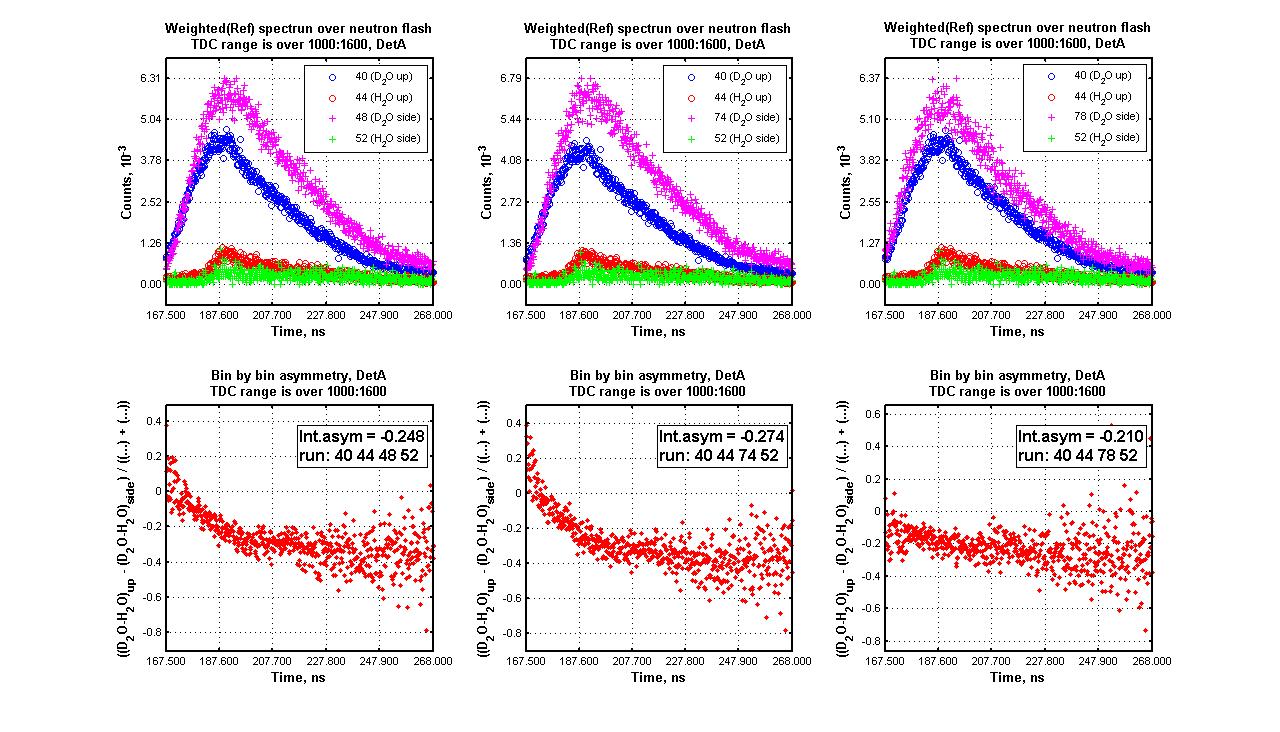Go Back
Integrated asymmetry calculation
[math]Asymm^{detA} = \frac{\left(\frac{up}{Wup}-\frac{upbg}{Wupbg}\right)^{detA} - \left(\frac{sd}{Wsd}-\frac{sdbg}{Wsdbg}\right)^{detA}}
{\left(\frac{up}{Wup}-\frac{upbg}{Wupbg}\right)^{detA} + \left(\frac{sd}{Wsd}-\frac{sdbg}{Wsdbg}\right)^{detA}}[/math]
[math]Asymm^{detC} = \frac{\left(\frac{up}{Wup}-\frac{upbg}{Wupbg}\right)^{detC} - \left(\frac{sd}{Wsd}-\frac{sdbg}{Wsdbg}\right)^{detC}}
{\left(\frac{up}{Wup}-\frac{upbg}{Wupbg}\right)^{detC} + \left(\frac{sd}{Wsd}-\frac{sdbg}{Wsdbg}\right)^{detC}}[/math]
where
[math]up=\sum{up(ii)}[/math] - D2O, detector Up
Wup - weighted coefficient (Nai or Ref)
[math]upbg=\sum{upbg(ii)}[/math] - H2O, detector Up
Wup - weighted coefficient (Nai or Ref)
[math]sd=\sum{sd(ii)}[/math] - D2O, detector Side
Wup - weighted coefficient (Nai or Ref)
[math]sdbg=\sum{sdbg(ii)}[/math] - H2O, detector Side
Wup - weighted coefficient (Nai or Ref)
- For detector A summation is over [1000:1600] bin numbers
- For detector C summation is over [900:1600] bin numbers
Error calculation
[math]Error = \sqrt{\left(\frac{\boldsymbol\partial A}{\boldsymbol\partial up}\right)^2(\boldsymbol\delta up)^2 +
\left(\frac{\boldsymbol\partial A}{\boldsymbol\partial Wup}\right)^2(\boldsymbol\delta Wup)^2 + ...}[/math]
If assume:
[math]\boldsymbol\delta up = \sqrt{up};\quad\boldsymbol\delta Wup = \sqrt{Wup};\quad...[/math]
what is [math]\sqrt{up}[/math] ? Does [math]\sqrt{up}[/math] = number of counts in in the detector up spectrum as suggested above? Why not use [math]N_{up}[/math] as variable. If distribution is Binomial (detector yes/no) then width of distribution is [math]1.265\sqrt{N}[/math] = 2 times e error. Relative error = [math]\frac{error}{Ave} = \frac{0.6325 \sqrt{N}}{N/2}[/math]
Then
[math]Error = \sqrt{\left(\frac{(+)-(-)}{(+)^2}\right)^2\left[\frac{up}{Wup^2}+\frac{up^2}{Wup}+\frac{upbg}{Wupbg^2}+\frac{upbg^2}{Wupbg}\right] +
\left(\frac{(+)+(-)}{(+)^2}\right)^2\left[\frac{sd}{Wsd^2}+\frac{sd^2}{Wsd}+\frac{sdbg}{Wsdbg^2}+\frac{sdbg^2}{Wsdbg}\right]}[/math]
where
[math](-)=\left[\left(\frac{up}{Wup}-\frac{upbg}{Wupbg}\right) - \left(\frac{sd}{Wsd}-\frac{sdbg}{Wsdbg}\right)\right][/math]
[math](+)=\left[\left(\frac{up}{Wup}-\frac{upbg}{Wupbg}\right) + \left(\frac{sd}{Wsd}-\frac{sdbg}{Wsdbg}\right)\right][/math]
Cases was analysed
Det A (was analized all possible combination):
D2O Up, files# [40,56,102,108,134,205,210,230];
H2O Up, files# [44];
D2O Side, files# [48,74,78,82,86,90,94,146,180,190,225,235];
H2O Side, files# [52];
Det C (was analized all possible combination):
D2O Up, files# [49,75,79,83,87,91,95,147,181,191,226,236];
H2O Up, files# [53];
D2O Side, files# [41,57,103,107,135,206,211,231];
H2O Side, files# [45];
Weighted coefficients was used
(File:Asymm table .pdf)
Results
Table 1: Det A, weighted with [math]{\color{Red}NaI \ detector}[/math]
Table 2: Det C, weighted with [math]{\color{Red}NaI \ detector}[/math]
Table 3: Det A, weighted with [math]{\color{Red}Ref \ detector}[/math]
Table 4: Det C, weighted with [math]{\color{Red}Ref \ detector}[/math]
(File:Asymm table .pdf)
Change the X-axis to nanosecond or neutron energy (TF). A:Will do it.
Only one "s" in Asymmetry. A:Will do it.
Example of bin by bin asymmetry

Go Back
